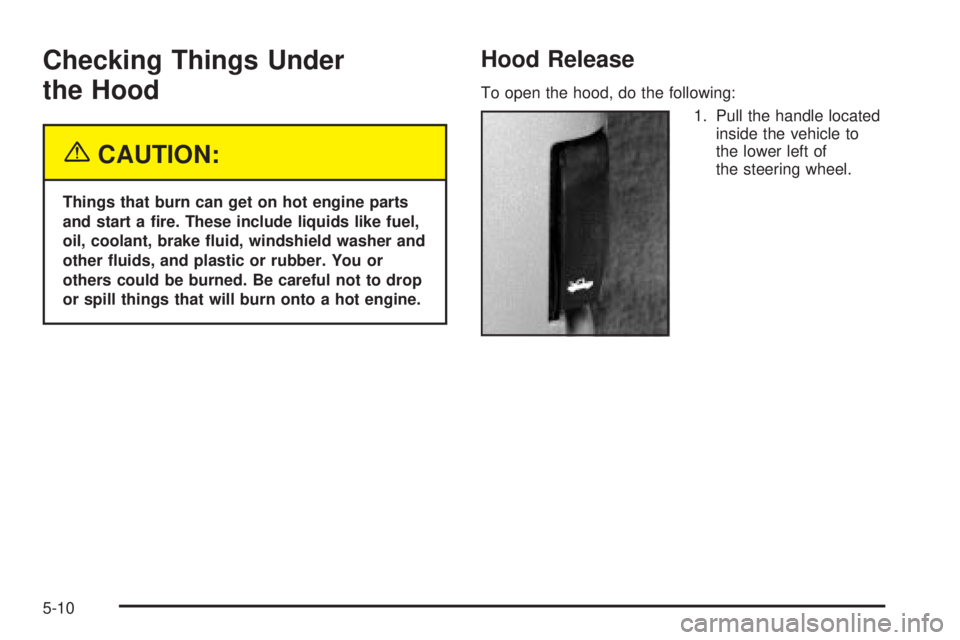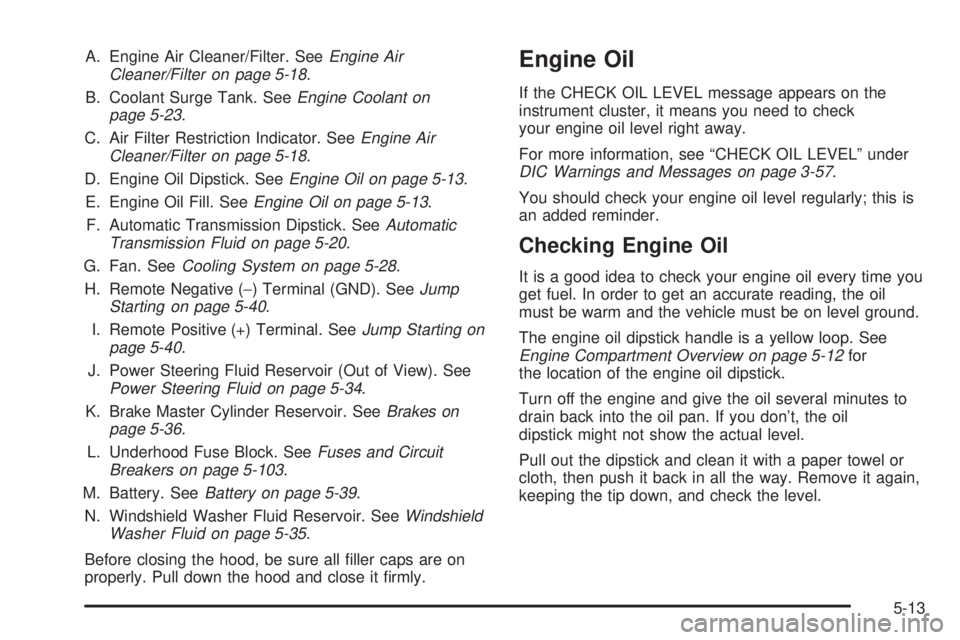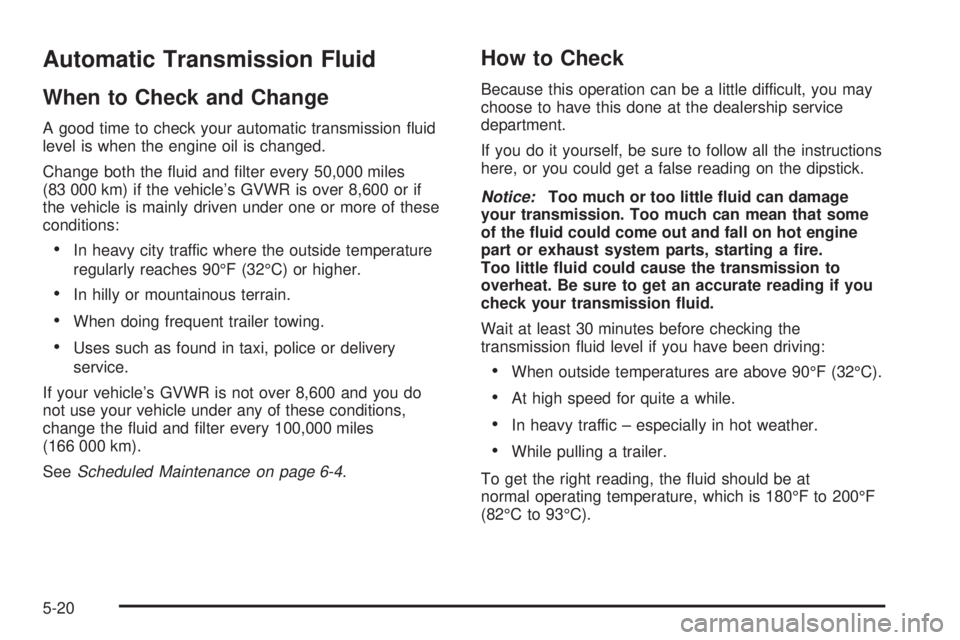2004 GMC YUKON DENALI checking oil
[x] Cancel search: checking oilPage 309 of 468

Service............................................................5-3
Doing Your Own Service Work.........................5-3
Adding Equipment to the Outside
of Your Vehicle...........................................5-4
Fuel................................................................5-4
Gasoline Octane............................................5-4
Gasoline Speci®cations....................................5-5
California Fuel...............................................5-5
Additives.......................................................5-6
Fuels in Foreign Countries...............................5-7
Filling Your Tank............................................5-7
Filling a Portable Fuel Container.......................5-9
Checking Things Under
the Hood....................................................5-10
Hood Release..............................................5-10
Engine Compartment Overview.......................5-12
Engine Oil...................................................5-13
Engine Air Cleaner/Filter................................5-18
Automatic Transmission Fluid.........................5-20
Engine Coolant.............................................5-23
Coolant Surge Tank Pressure Cap..................5-25Engine Overheating.......................................5-25
Cooling System............................................5-28
Engine Fan Noise.........................................5-33
Power Steering Fluid.....................................5-34
Windshield Washer Fluid................................5-35
Brakes........................................................5-36
Battery........................................................5-39
Jump Starting...............................................5-40
All-Wheel Drive..............................................5-45
Rear Axle.......................................................5-46
Front Axle......................................................5-47
Bulb Replacement..........................................5-48
Halogen Bulbs..............................................5-48
Headlamps..................................................5-48
Front Turn Signal, Sidemarker and
Daytime Running Lamps.............................5-49
Center High-Mounted Stoplamp (CHMSL).........5-51
Taillamps.....................................................5-51
Replacement Bulbs.......................................5-52
Section 5 Service and Appearance Care
5-1
Page 318 of 468

Checking Things Under
the Hood
{CAUTION:
Things that burn can get on hot engine parts
and start a ®re. These include liquids like fuel,
oil, coolant, brake ¯uid, windshield washer and
other ¯uids, and plastic or rubber. You or
others could be burned. Be careful not to drop
or spill things that will burn onto a hot engine.
Hood Release
To open the hood, do the following:
1. Pull the handle located
inside the vehicle to
the lower left of
the steering wheel.
5-10
Page 321 of 468

A. Engine Air Cleaner/Filter. SeeEngine Air
Cleaner/Filter on page 5-18.
B. Coolant Surge Tank. See
Engine Coolant on
page 5-23.
C. Air Filter Restriction Indicator. See
Engine Air
Cleaner/Filter on page 5-18.
D. Engine Oil Dipstick. See
Engine Oil on page 5-13.
E. Engine Oil Fill. See
Engine Oil on page 5-13.
F. Automatic Transmission Dipstick. See
Automatic
Transmission Fluid on page 5-20.
G. Fan. See
Cooling System on page 5-28.
H. Remote Negative (-) Terminal (GND). See
Jump
Starting on page 5-40.
I. Remote Positive (+) Terminal. See
Jump Starting on
page 5-40.
J. Power Steering Fluid Reservoir (Out of View). See
Power Steering Fluid on page 5-34.
K. Brake Master Cylinder Reservoir. See
Brakes on
page 5-36.
L. Underhood Fuse Block. See
Fuses and Circuit
Breakers on page 5-103.
M. Battery. See
Battery on page 5-39.
N. Windshield Washer Fluid Reservoir. See
Windshield
Washer Fluid on page 5-35.
Before closing the hood, be sure all ®ller caps are on
properly. Pull down the hood and close it ®rmly.
Engine Oil
If the CHECK OIL LEVEL message appears on the
instrument cluster, it means you need to check
your engine oil level right away.
For more information, see ªCHECK OIL LEVELº under
DIC Warnings and Messages on page 3-57.
You should check your engine oil level regularly; this is
an added reminder.
Checking Engine Oil
It is a good idea to check your engine oil every time you
get fuel. In order to get an accurate reading, the oil
must be warm and the vehicle must be on level ground.
The engine oil dipstick handle is a yellow loop. See
Engine Compartment Overview on page 5-12for
the location of the engine oil dipstick.
Turn off the engine and give the oil several minutes to
drain back into the oil pan. If you don't, the oil
dipstick might not show the actual level.
Pull out the dipstick and clean it with a paper towel or
cloth, then push it back in all the way. Remove it again,
keeping the tip down, and check the level.
5-13
Page 328 of 468

Automatic Transmission Fluid
When to Check and Change
A good time to check your automatic transmission ¯uid
level is when the engine oil is changed.
Change both the ¯uid and ®lter every 50,000 miles
(83 000 km) if the vehicle's GVWR is over 8,600 or if
the vehicle is mainly driven under one or more of these
conditions:
·In heavy city traffic where the outside temperature
regularly reaches 90ÉF (32ÉC) or higher.
·In hilly or mountainous terrain.
·When doing frequent trailer towing.
·Uses such as found in taxi, police or delivery
service.
If your vehicle's GVWR is not over 8,600 and you do
not use your vehicle under any of these conditions,
change the ¯uid and ®lter every 100,000 miles
(166 000 km).
See
Scheduled Maintenance on page 6-4.
How to Check
Because this operation can be a little difficult, you may
choose to have this done at the dealership service
department.
If you do it yourself, be sure to follow all the instructions
here, or you could get a false reading on the dipstick.
Notice:Too much or too little ¯uid can damage
your transmission. Too much can mean that some
of the ¯uid could come out and fall on hot engine
part or exhaust system parts, starting a ®re.
Too little ¯uid could cause the transmission to
overheat. Be sure to get an accurate reading if you
check your transmission ¯uid.
Wait at least 30 minutes before checking the
transmission ¯uid level if you have been driving:
·When outside temperatures are above 90ÉF (32ÉC).
·At high speed for quite a while.
·In heavy traffic ± especially in hot weather.
·While pulling a trailer.
To get the right reading, the ¯uid should be at
normal operating temperature, which is 180ÉF to 200ÉF
(82ÉC to 93ÉC).
5-20
Page 455 of 468

Care of
Safety Belts................................................5-95
Your Cassette Tape Player............................3-97
Your CD and DVD Player.............................3-99
Your CD Changer........................................3-98
Your CDs and DVDs....................................3-98
Cargo Cover..................................................2-46
Cargo Tie Downs............................................2-47
Cassette Tape Messages.................................3-76
CD Adapter Kits.............................................3-77
CD Changer...................................................3-93
CD Changer Errors.........................................3-95
CD Functions.................................................3-94
CD Messages................................................3-79
Center Console Storage Area...........................2-44
Center High-Mounted Stoplamp (CHMSL)...........5-51
Center Instrument Panel Fuse Block................5-106
Center Passenger Position, Safety Belts.............1-39
Chains, Tires..................................................5-72
CHANGE ENGINE OIL....................................3-58
Charging System Light....................................3-35
Check
Engine Light...............................................3-40
Check Engine Light.........................................3-40
CHECK OIL LEVEL.........................................3-58
CHECK TIRE PRESSURE...............................3-58
CHECK WASHER FLUID.................................3-58
Checking Brake Fluid......................................5-37
Checking Coolant............................................5-24
Checking Engine Oil........................................5-13Checking Things Under the Hood......................5-10
Checking Your Restraint Systems......................1-86
Chemical Paint Spotting.................................5-100
Child Restraints
Child Restraint Systems...............................1-54
Infants and Young Children...........................1-50
Lower Anchorages and Top Tethers for
Children (LATCH System)..........................1-61
Older Children.............................................1-48
Securing a Child Restraint Designed for the
LATCH System........................................1-63
Securing a Child Restraint in a Center Rear
Seat Position...........................................1-65
Securing a Child Restraint in a Rear Outside
Seat Position...........................................1-63
Securing a Child Restraint in the Right Front
Seat Position...........................................1-68
Top Strap...................................................1-57
Top Strap Anchor Location............................1-59
Where to Put the Restraint...........................1-56
Chime Level Adjustment..................................3-99
Cigarette Lighter.............................................3-19
Cleaning
Inside of Your Vehicle..................................5-93
Outside of Your Vehicle................................5-96
Underbody Maintenance...............................5-99
Video Screen..............................................3-99
Weatherstrips..............................................5-95
Cleaning Aluminum Wheels..............................5-98
Cleaning Exterior Lamps/Lenses.......................5-96
3
Page 459 of 468

G
Gage
Engine Coolant Temperature.........................3-38
Fuel..........................................................3-45
Oil Pressure...............................................3-43
Speedometer..............................................3-32
Tachometer.................................................3-32
Transmission Temperature.............................3-39
Voltmeter Gage...........................................3-36
Garage Door Opener.......................................2-39
Gasoline
Octane........................................................ 5-4
Speci®cations............................................... 5-5
Gate Operator and Canadian Programming........2-42
Getting Familiar with Off-Road Driving................4-18
Glove Box.....................................................2-43
GM Mobility Program for Persons with
Disabilities.................................................... 7-5
H
Hazard Warning Flashers................................... 3-6
Head Restraints............................................... 1-6
Headlamp High/Low-Beam Changer.................... 3-8
Headlamps....................................................5-48
Bulb Replacement.......................................5-48
Front Turn Signal, Sidemarker and Daytime
Running Lamps........................................5-49
Halogen Bulbs............................................5-48Headphones...................................................3-87
Heated Seats................................................... 1-4
Heating.........................................................3-24
Highway Hypnosis...........................................4-35
Hill and Mountain Roads..................................4-35
Hitches..........................................................4-56
HomeLink
žTransmitter....................................2-39
HomeLinkžTransmitter, Programming................2-40
Hood
Checking Things Under................................5-10
Release.....................................................5-10
Horn............................................................... 3-7
How to Add Coolant to the Coolant Surge Tank......5-30
How to Add Fluid............................................5-22
How to Check........................................5-20, 5-63
How to Check Lubricant...................................5-46
How to Check Power Steering Fluid..................5-34
How to Inspect...............................................5-18
How to Use This Manual...................................... ii
How to Wear Safety Belts Properly...................1-30
Hydroplaning..................................................4-31
I
If No Steam Is Coming From Your Engine..........5-27
If Steam Is Coming From Your Engine...............5-26
If the Light is Flashing.....................................3-41
If the Light Is On Steady.................................3-42
If You Are Caught in a Blizzard.........................4-39
7